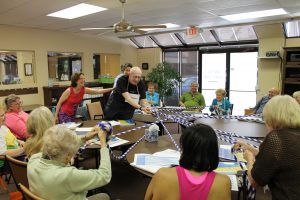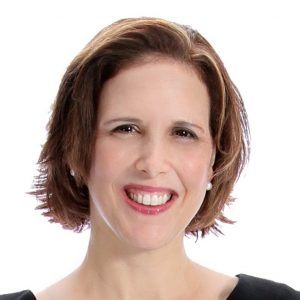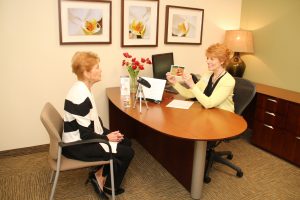Parkinson Voice Project’s Speech and Swallowing Therapy Program Goes Global

Parkinson’s patients play a game at a Loud Crowd speech therapy session in Dallas. Parkinson Voice Project CEO Samantha Elandary is standing at left. (Photos courtesy of PVP)
Samantha Elandary has been dreaming for years of making the Parkinson’s speech and swallowing therapy program she developed in her Dallas, Texas, living room available worldwide.
If she sounds excited these days, it’s because the pace of progress at her nonprofit group, Parkinson Voice Project has shifted from a trot to a gallop over the past two years — thanks to initiatives boosting the number of trained U.S. and overseas speech therapists, and making it easier for patients in other countries to obtain course material.
One initiative is an online course that lets speech pathologists take the training without coming to Dallas, Elandary told Parkinson’s News Today in a phone interview. Another is making the therapy workbook available online to non-U.S. patients, since the paper version would cost too much to ship.
Next year, the nonprofit also plans to produce its therapist training video, available now in English and Spanish, in other languages, starting with French. In addition, a new grants program is defraying start-up costs for U.S. and overseas clinics that want to introduce the project, prompting many to join in. The second year of grant winners was announced in April — Parkinson’s Awareness Month.
Yet another initiative is the creation of a $50 million endowment to cover the project’s operating costs and fund its grants program.
All this has led to a surge in the number of therapists and patients using the two components of the project — Speak Out! and its follow-up, Loud Crowd — which are now available in all 50 U.S. states and 13 countries, Elandary said.
Between 2012 and 2017, Parkinson Voice Project trained about 300 therapists in Dallas, many of them from outside Texas. Since 2017, the combination of the online training course and the grants program — which covers the $289 course fee and other expenses — has quadrupled the number of trained therapists to 1,300, yielding a grand total of 1,600. More than 40 were from other countries.
Elandary is thrilled with the progress, although she would be the first to say her team is just scratching the surface, given that the world is home to between 7 million and 10 million Parkinson’s patients. She said the benefits go beyond speech improvement.
“More important than that, the same muscles we use for speaking are the same muscles we use for swallowing,” she said. She noted that swallowing difficulties lead to aspiration pneumonia, accounting for 70 percent of Parkinson’s deaths.
Elandary was born with a cleft palate that gave her firsthand experience with speech difficulties. She entered the University of North Texas in Denton intent on teaching English. But she liked the courses in her speech therapy minor so much that she earned a master’s in the field.
Trial and error
In her first five years of working at a hospital after graduation, she helped patients with speech problems caused by larynx operations, brain injuries, strokes, and Parkinson’s.
Then a supervisor asked her to head the Parkinson’s program. “I loved it,” she said — and her career course was set.
But the federal government capped Medicare’s therapy benefits in 1998, and “it became very clear that people with Parkinson’s were not going to receive the treatment they needed,” she said.
So Elandary left the hospital that year and opened a Parkinson’s program in her home. Her group sessions started in the living room, but quickly spilled into the dining room, the kitchen, and the back office.
Recognizing the need for a better Parkinson’s speech-improvement program, she began developing one by trial and error.
Her final version has two phases. The first, Speak Out!, consists of 12 weeks of one-on-one therapy to increase voice strength and clarity. Parkinson’s patients lack the neurotransmitter dopamine that controls the speech process automatically, she said. Unless they consciously exercise their voice — what she calls speaking with intent — most lose capacity, speaking too softly, hoarsely, or unintelligibly.
The six-part Speak Out! regimen involves repeating particular sounds in certain cadences, plus reading out loud. After completing the first phase, participants move on to Loud Crowd, whose goal is to maintain voice strength through conversations, games, singing and other activities.
Loud Crowd is also a great chance for participants to socialize, said Gay Gilmore, a retired nurse who takes part in the sessions.
“These sessions become a lifeline for many people,” she said. “They keep you in touch with others facing the same challenges — and they help your voice. The program has enabled me to be more in charge of myself, more in charge of what I have to say.”
Gilmore recalled one woman in particular who blossomed after becoming a Loud Crowd member.
“She was really withdrawn at first,” Gilmore said. “But she would brighten a little more at every meeting, and her voice would become a little stronger.” Over time, she had no trouble speaking up — and became talkative, Gilmore said.
Adapting for a worldwide reach
Sticking with Elandary’s initial goal of providing therapy to any patient who needs it, regardless of means, the organization adopted its nonprofit model in 2005. All patients get free training. When they finish, they are encouraged to “pay it forward” by donating to the charity.
Elandary began a pilot project in 2012 to train two Oklahoma speech therapists so they could replicate the program. Seven years later, 35 Oklahoma speech language pathologists have been trained by the project. In addition, more than 900 Parkinson’s patients have been treated, and 15 Loud Crowd groups have formed at five hospitals.
Japanese therapists became the program’s first non-U.S. participants in 2013.
But the biggest step in accelerating the advocacy group’s growth worldwide was creating the online training course.
“It was the hardest project I’ve ever done, but it is the one that has finally gotten us making some headway,” Elandary said. It started with her writing a 250-page script, which the charity’s medical advisory board checked “to make sure the neurology was right.”
Then it needed to be filmed and professionally voiced over. Four years and $100,000 later, it was ready.
The online course teaches speech therapists both how to work with patients on exercises, and how to motivate them.
The idea of the grants program came from a Loud Crowd member in Dallas. She wanted to ensure that therapists would not only be trained in Speak Out!, but would also start Loud Crowd programs — since maintaining voice strength is so vital to a Parkinson’s patient’s well-being, Elandary said.
In 2018, the program’s first year, 93 American clinics received grants. So far this year, the number of applications has jumped to 149 — and the organization has already shipped 1,009 patient workbooks to clinics outside Dallas.
“People with Parkinson’s can make such good progress in a short amount of time” with the right therapy, Elandary said. “I hate for them not to have access to this therapy that could really make a difference in their lives.”









